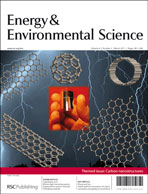Electrical energy can be obtained from the controlled mixing of fresh (river) and saline (sea) water. Existing technologies such as pressure retarded osmosis and reverse electrodialysis make use of ion-exchange membranes which must be crossed by either the water or the ions. Recently a new physical principle has been experimentally demonstrated, which allows extraction of electrical energy without making use of membranes, based on the temporary storage of ions inside two porous electrodes kept at different electrical potentials, and the repeatable expansion/contraction of the electrostatic double layers formed inside the electrodes upon changing the salt concentration [D. Brogioli, Phys. Rev. Lett., 2009, 103, 058501]. To make further investigations and to improve the energy recovery, we developed a simple prototype cell of much larger dimensions. Because of the larger dimensions (thus higher currents), testing is more facile, while this design can be the basis for further scaling-up of this technology. In order to reduce the internal resistance of the cell, the electrodes are no longer placed side-by-side, but parallel to one another, separated only by a 250 μm-thick open spacer channel to form a “sandwich”-like flow cell. In a lab-scale experimental stack consisting of 8 such cells (with outer dimensions 6 × 6 × 1 cm3) we extract about 2 J per charging/discharging cycle in 500 mM/1 mM NaCl salt solution, an amount which is 20 times higher per cycle per unit electrode mass than previously obtained. The extracted energy increases with the operating voltage, in line with predictions of the Gouy-Chapman-Stern model for double layer formation.

This article is Open Access
 Please wait while we load your content...
Something went wrong. Try again?
Please wait while we load your content...
Something went wrong. Try again?


 Please wait while we load your content...
Please wait while we load your content...